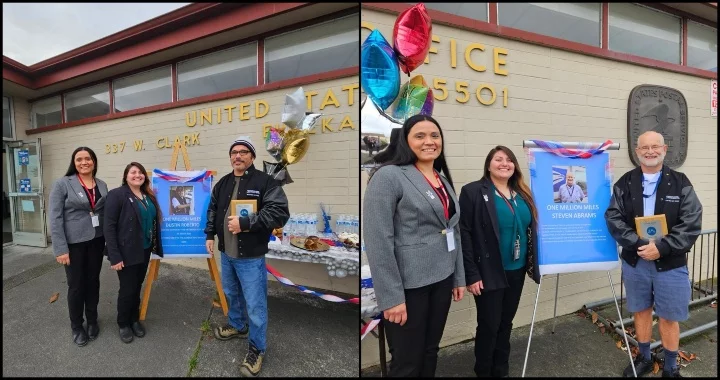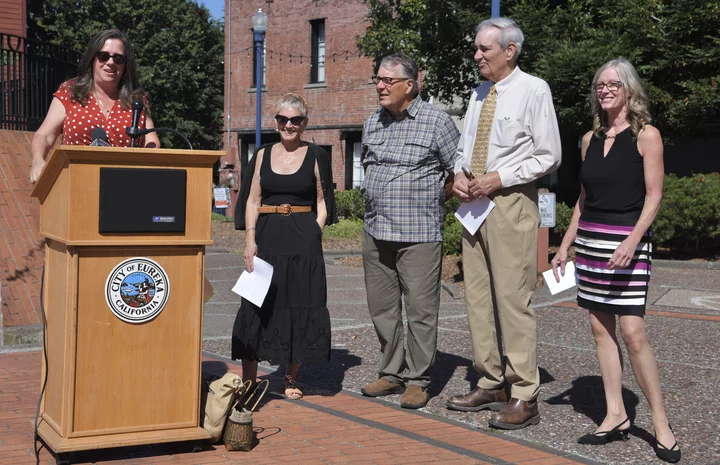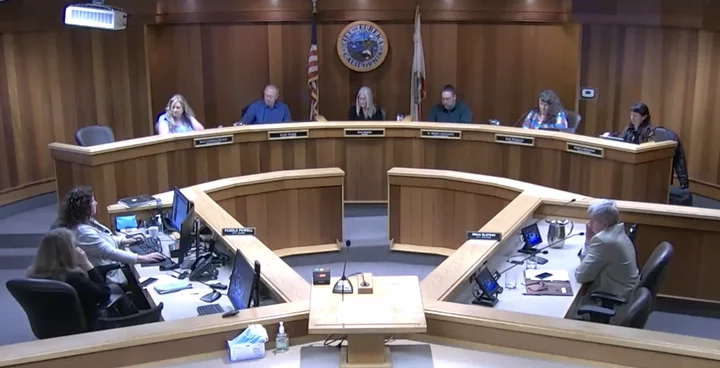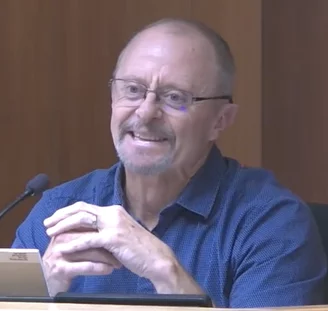The MILLION MILE CLUB! These Two Eureka-Based Letter Carriers Have Been Inducted Into a Prestigious U.S. Mail Hall of Fame, and Their Amazing Accomplishment Took Place Entirely Within City Limits
LoCO Staff / Thursday, Nov. 6 @ 1:43 p.m. / Infrastructure
Roberto (left) and Abrams (right) pose separately with some USPS bigwigs. Photos: USPS.
Press release from the U.S. Postal Service:
The Eureka Post Office, located at 337 W Clark St, Eureka, CA 95501 inducted Letter Carriers Dustin Roberto and Steven Abrams today into the prestigious National Safety Council Million Mile Award.
The Million Mile Award is a lifetime enrollment, awarded to letter carriers, rural carriers and truck drivers, who have a safe attitude that entails driving for one million miles or 30 years without a preventable incident. They receive a plaque which bears the Million Mile Club emblem, the NSC logo and an engraved personalized nameplate.
Dustin Roberto, a Veteran and Letter Carrier for 35 years received recognition and entry into the program just ahead of his retirement on November 14.
Steven Abrams began his postal career 32 years ago in Los Gatos before joining the Eureka station where he has served for nearly the entirety of his career for 31 years.
The secret to staying accident-free starts with having the right mindset, “Eliminate the distractions in the driver cabin while driving. To me, safety means working in a safe manner that protects not only myself but my coworkers so we can return to our families every day,” said Abrams.
Roberto emphasized it is key to “always take the time to be safe.”
Driving a million miles safely is commendable.
To add perspective, the moon is 238,900 miles from planet earth. Driving one million miles is the equivalent of doing that journey more than four times, all without a moving violation or accident, while maneuvering hazardous road conditions, gridlock, rural terrain, and avoiding careless drivers along the way.
“Our postal drivers take safety very seriously,” said Eureka Postmaster Heather McTigue, “this truly remarkable achievement demonstrates how postal employees continue to deliver on the promise of delivering their best every day with care, courtesy and concern for the safety of others.”
Safe Driving Habits Start with Good Training
Driving for Postal Service is a privilege. All drivers must demonstrate safe-driving practices throughout their careers. Behind-the-wheel job candidates undergo rigorous screening, training, and certification process to earn credentials to operate a right-hand drive postal vehicle.
BOOKED
Yesterday: 7 felonies, 9 misdemeanors, 0 infractions
JUDGED
Humboldt County Superior Court Calendar: Today
CHP REPORTS
No current incidents
ELSEWHERE
Growing Pains, with Nick Flores: #231 - China’s Rise: Trade Wars, Myths, and U.S. Policies with Elizabeth O’Brien Ingleson
RHBB: Sneaker Wave Risk Expected Monday Morning Through Tuesday Along Northwest California Coast
RHBB: Two Teachers at Cal Poly Named on Turning Point USA’s Professor Watchlist
AP News: Investigators plead for tips after 3 children, 1 adult killed in shooting at child’s birthday party
Centro del Pueblo’s Annual March From Fortuna to Eureka Happens This Saturday
LoCO Staff / Thursday, Nov. 6 @ 10:50 a.m. / Community
The Fortuna to Eureka Procession is a long-distance community walk that raises awareness about the human rights of migrants in Humboldt County. By symbolically connecting Fortuna, home to the largest Latine community in the region, with Eureka, where the courthouse and essential services are located, we highlight the disparities and the urgent need for protection and dignity for migrant families.
This walk is a public statement in action that migrants deserve spaces free of violence. Every year we demand the closure of detention centers, the reunification of separated families, and the full implementation of sanctuary protections. Centro del Pueblo leads to affirm our collective presence in public space and to say: We are here to stay!
How You Can Help
1. Food & Welcome Space
- Provide food along the walking route
- Help prepare the welcome space at our office on Broadway Avenue
2. Materials Needed
- Banners and signs
- Whistles
- Volunteer to transport butterfly wings to Pearson’s
- Rain ponchos
- Volunteer to transport food and water during the walk
3. Transportation & Safety
- Rides from Arcata, McKinleyville, or Eureka to Fortuna
- Volunteers to drive walkers’ cars from Fortuna to Eureka (to reduce fatigue after 8+ hours of walking)
- Car escorts for safety
- Police liaison for de-escalation
- Community members willing to join the walk or help monitor safety via our chat
If you want to support, please text 707-683-5293 or email info@cdpueblo.com.
REASSEMBLE! Eureka’s Past Five Mayors are Uniting for Christmas Once Again, and This Time They’re Bringing Along a Squad of Cartoon Sidekicks
LoCO Staff / Thursday, Nov. 6 @ 7:42 a.m. / Economy
The five mayors of Eureka Past. From left: Peter LaVallee, Susan Seaman, Nancy Flemming, Virginia Bass, Frank Jager.
Press release from Eureka for the Holidays:
It’s the start of another busy holiday season, and with it a variety of activities and events to keep straight. Luckily, the former mayors of Eureka have joined forces to offer the community and visitors an easier way to enjoy and manage the holiday festivities this year as they kick off the season with Eureka for the Holidays.
In addition to holiday favorites, this year’s activities will be centrally located on an easily-accessible website, with some help from three new and festive mascots along the way.
“We wanted to take the opportunity this year to uplift all of the great things that already happen around the holiday season all across Eureka,” said Susan Seaman, former mayor and program director of the North Edge Business Financing and Community Development. “By coordinating and marketing all of our activities, we hope to boost activity participation and sales for our planners and merchants while also providing a one-stop holiday planning guide to our busy residents.”
Community members and business owners are encouraged to visit the online calendar to submit their own holiday season events to the community. The calendar will feature Eureka’s diverse holiday celebrations, including pop-up markets, holiday activities, community gatherings, toy drives, business events and sales, fundraisers, volunteer opportunities, and faith-based services. It will serve as a comprehensive guide for community members to explore the wide array of offerings from Eureka and its local businesses throughout the holiday season. Additionally, the website offers information on the annual Home for the Holidays Decorating contest and a downloadable media kit, featuring festive coloring sheets for the youngest attendees.
“Our strength as a community comes from the work we do together, from our youngest citizens — like our Scouts — to those of us who have held higher leadership positions,” said Frank Jager, past mayor. “Eureka for the Holidays is the perfect opportunity to demonstrate that effort.”
The website, VisitEureka.com/Holiday will be launching shortly. In the meantime, if you have an event, you can go to this link..
About Eureka for the Holidays
Eureka for the Holidays is a partnership between the former mayors of Eureka, Humboldt Made, City of Eureka, Greater Eureka Chamber of Commerce, Eureka Main Street, and Henderson Center Merchants to help promote and support the small businesses in the Eureka area during the holiday season. It is an opportunity to celebrate the holidays and unite the community. Sponsors for this event include Coast Central Credit Union, Illuminated Marketing, and Maples Service.
###
NOW LET’S GET TO KNOW THESE EUREKA HOLIDAY MASCOTS:
Kris Kringlefoot
Kris Kringlefoot is Humboldt’s friendliest Sasquatch. He can often be seen strolling through Old Town with a cup of hot cocoa (extra whip AND sprinkles) from Old Town Coffee & Chocolates. He loves stopping to admire the gazebo holiday lights and makes sure the bulk of his Christmas shopping is done downtown. For Kris, the holiday season is all about kindness, laughter, and supporting his community.
Yule
Carrying a wrapped gift from Toy Box and nibbling on holiday cookies from Cherry Blossom Bakery, Yule is our quirky, cheerful, full-of-holiday-spirit banana slug. Yule’s calendar is pretty packed this time of year with holiday events and prepping for the Home for the Holidays Decorating Contest (they win every year!) They often employ the help of their friends, Kris and Red, to string up the higher lights and thanks them with sweet treats from Fresh Freeze.
Red
Red is a redwood who loves getting dressed up for the holidays. She eagerly waits for Pierson’s and The Carl Johnson Company to set up their holiday displays and leaves their stores having purchased some new favorite jewelry (ornaments) to show off at the Sequoia Park Zoo. For Red, the holiday season doesn’t officially start until she’s crossed these two off her list.
The non-cartoonified, IRL version of The Five Mayors assembled for the first time last year, laser-focused on bringing Christmas joy to the streets of Eureka. File photo: Izzy Vanderheiden.
Gavin Newsom ‘Light Years Ahead’ in 2028 Democratic Field After Prop. 50 Win
Jeanne Kuang / Thursday, Nov. 6 @ 6:45 a.m. / Sacramento
Gov. Gavin Newsom speaks to the press, alongside First Partner Jennifer Siebel Newsom, after Proposition 50 was passed by California voters, at the California Democratic Party headquarters in Sacramento on Nov. 4, 2025. Photo by Jungho Kim for CalMatters
###
This story was originally published by CalMatters. Sign up for their newsletters.
###
Gov. Gavin Newsom has a message for Democrats around the country: Follow my lead.
Declaring victory for Proposition 50, his Democratic redistricting ballot measure, he named five other states led by Democrats and urged their governors to tilt their own congressional maps in favor of the party and help it secure the U.S. House in next year’s midterms.
“We need to see other states, their remarkable leaders that have been doing remarkable things, meet this moment head-on as well,” he said. “We can de facto end Donald Trump’s presidency as we know it, the minute Speaker Jeffries gets sworn in as speaker of the House of Representatives. It is all on the line.”
It had the decisive air of a politician claiming the national mantle. And though he nodded to House Democratic leader Hakeem Jeffries’s role, the subtext was clear: Newsom was the one who just delivered the party the likelihood of five new seats in Congress.
With Prop. 50’s overwhelming passage, the governor has vaulted — for the moment — into the role of Democratic favorite in the 2028 presidential campaign. Newsom’s national ambitions have never been veiled, but this year he for the first time acknowledged he’s considering it. Having amassed more than tens of thousands of new donors nationwide to support his ballot measure, he also now has a roster of supporters to call on in a potential campaign.
Cable news shows lit up with mentions of the governor’s success at pulling off the redistricting gambit. MSNBC commentator and former Missouri Sen. Claire McCaskill declared Newsom has “moved to the front of the pack” among potential 2028 Democratic presidential contenders such as Illinois Gov. J.B. Pritzker.
“He’s in the top tier,” said Democratic pollster and strategist Celinda Lake. “It was a really outside-the-box idea, implemented well, implemented fast, united the party. And it also showed he was tough.”
Yet one victory in an off-year election driven by the nationwide mood of angry Democrats decidedly set against Trump does not necessarily predict a future successful campaign. Prop. 50 was purely anti-Trump, and Democratic strategist Matt Rodriguez said Democrats still need an independent vision to win back Congress or the White House.
But looking at possible 2028 contenders, “there’s no question (Newsom is) light years ahead of everyone else.”
“He’s the only one driving his own news,” he said. “Everyone else is like a moth to flame.”
‘Iterating’ a vision and a message
Newsom’s prospects for national prominence weren’t always so bright. For years, he’s been experimenting with how to get attention by confronting Republicans on the national stage, challenging them to debates on Fox News and bankrolling red-state billboards advertising California’s reproductive rights. In 2023 he similarly called on other states’ lawmakers to follow his lead for a constitutional amendment on gun control. No other state joined the effort.
In the first few months of 2025, as Democrats struggled with how to recover from the 2024 loss to Trump, Newsom was podcasting with right-wing activists and mulling their successes. It was the latest in a series of his efforts to try on new political approaches, which the governor frequently describes to reporters as “iterating.”
When Texas Democrats approached Newsom for support over the summer as they tried to fight off a Trump-backed GOP gerrymandering effort there, a counter-proposal from California was considered an extraordinary political risk for the governor.
It wasn’t clear all Democrats in California’s congressional delegation or the state Legislature were on board, let alone a majority of the state’s voters. But by the end of a 10-week campaign, so many people had donated to support the measure that Newsom told them to stop sending money, while two opposition campaigns failed to capture attention with a cohesive message.
“I don’t think I’ve ever seen the entirety of the left of politics in California come together in this way in a campaign,” said Neel Sannappa, an organizer with the left-wing California Working Families Party and chair of the California Democrats’ Progressive Caucus.
A knack for trolling
Newsom succeeded, strategists said, by taking a risk in an almost impromptu way that was well-timed with voters’ mounting alarms about Trump’s deployment of the National Guard to American cities, aggressive immigration raids and redistricting efforts in other states.
It didn’t hurt his own standing that he was also engaging in a social media trolling campaign against Trump, adding to perceptions that he was willing to embrace the brash, unconventional politics that led to the president’s own rise. The posts — often AI-generated, sometimes crude, and always extremely online — have delighted Democrats in a way even skeptical progressives like Sannappa commended.
“He was thrust into the spotlight as a result of this particular situation (with Texas) and I think he made the most of it,” said Brian Brokaw, a strategist who advises Newsom. “One of his greatest strengths is his ability to evolve with changing times and changing dynamics … It’s reflected in the positive results of last night.”
Months ago, Newsom already acknowledged that one day the tweets will get old, and he would need a new strategy.
“We’re iterating,” he said at an August event hosted by Politico. “That’s been the cause of my life.”
Rep. Nancy Pelosi Announces Retirement After 38 Years in Congress
Maya C. Miller / Thursday, Nov. 6 @ 6:36 a.m. / Sacramento
Pelosi in 2019. Gage Skidmore from Peoria, AZ, United States of America, CC BY-SA 2.0, via Wikimedia Commons
###
This story was originally published by CalMatters. Sign up for their newsletters.
###
Speaker Emerita Nancy Pelosi, the trailblazing lawmaker who made history as the first woman to lead the U.S. House of Representatives and a singular force in Democratic politics, announced Thursday that she will retire at the end of 2026 and not seek a 21st term in Congress.
Pelosi, 85, who has represented San Francisco in the House since 1987, announced her decision Thursday in a nearly six-minute cinematic love letter to the city and her constituents.
“I’ve always honored the song of St. Francis — ‘Lord, make me an instrument of thy peace,’ — the anthem of our city,” Pelosi, who is a devout Catholic, says near the end of the mini film. “That is why I want you, my fellow San Franciscans, to be the first to know: I will not be seeking re-election to Congress.”
Interspersed with the montage of San Francisco scenes were nods to Pelosi’s signature legislative accomplishments, including the passage of the Affordable Care Act under President Barack Obama and the passage of former President Joe Biden’s infrastructure and climate agenda.
Pelosi is known for her political prowess, strict leadership and laser-focused vision that made her an exceptionally effective and fearsome speaker. She frequently twisted arms within her own party, quelling an uprising from the progressive flank of the Democratic caucus known as “the Squad” in 2018 and even backchanneling the pressure campaign that led to Biden’s exit from the 2024 presidential race.
She also gained a reputation for her not-so-subtle sass of President Donald Trump, going viral for ripping up his State of the Union speech and mockingly giving him the now-iconic “Nancy clap” of disapproval. Her antagonism of the president also made her a target for political violence. When Jan. 6 rioters stormed the Capitol in 2021, many were looking for her specifically. Pelosi’s husband of more than 60 years, Paul Pelosi, was brutally beaten by an intruder with a hammer who’d broken into the couple’s San Francisco residence looking for her.
Her video features clever shout-outs to the wide array of industries and interests that have supported — and tangled with — her over the years: labor unions, tech companies, public transit and housing advocates, environmentalists and entrepreneurs. She also notes the city’s struggles, focusing on the recovery from the 1989 Loma Prieta earthquake and the AIDS crisis.
“Here we don’t fear the future, we forge it,” Pelosi says. “From the Gold Rush to the miracles of science and technology, our city has always been the cradle of innovation, buzzing with optimism and creativity.”
Pelosi is a longtime force of the city and the Democratic Party, serving as chair of the California party from 1981 to 1983. She raised five children and was active as a volunteer in local politics for years, but didn’t seriously consider running for office until her 40s. She has spoken often of her Catholic upbringing in Baltimore, where her father served as mayor for 12 years. Her brother later followed in his footsteps.
Her announcement comes amid an outcry from Democrats to let a younger generation take the helm. State Sen. Scott Wiener, who has called Pelosi his mentor, announced last month that he would seek her seat next year.
Wiener joins a race that also includes progressive challenger Saikat Chakrabarti, the former chief of staff to Rep. Alexandria Ocasio Cortez of New York.
Her idyllic video notably steers clear of any mention of Trump, who has threatened repeatedly to send troops and immigration agents to San Francisco.
“San Francisco, know your power,” Pelosi says. “We have made history, we have made progress, we have always led the way, and now we must continue to do so.”
Why a New California Law Could Change the Way All Americans Browse the Internet
Colin Lecher / Thursday, Nov. 6 @ 6:32 a.m. / Sacramento
California is requiring browsers to offer a signal that the user does not want their personal data sold or shared. Experts say this has national implications. A person uses their phone in Escondido on April 20, 2023. Photo by Lauren Justice for CalMatters
###
This story was originally published by CalMatters. Sign up for their newsletters.
###
The privacy changes web browsers will be required to make under a new California law could set the de facto standard for the entire country, changing how Americans control their data when using the internet, according to experts.
Assembly Bill 566, recently signed into law by Gov. Gavin Newsom, requires companies that make web browsers to offer users an opt-out “signal” that automatically tells websites not to share or sell their personal information as they browse.
“We expect it to have a national impact.”
— Emory Roane, Privacy Rights Clearinghouse
It will likely be easier for companies to roll out the service for the entire country, rather than for users only in California.
“It’s such a trivial implementation,” said Emory Roane, associate director of policy at Privacy Rights Clearinghouse, an organization that pushed for the legislation. “It’s really not that difficult technically.”
The legislation, a first of its kind in the country, was sponsored by the California Privacy Protection Agency, the state’s consumer privacy watchdog, as well as several consumer advocacy and privacy rights groups.
Under the law, browsers like Google’s Chrome and Microsoft’s Edge will have until the beginning of 2027 to create a way for consumers to select the signal. Combined with recent changes from other states, the new law could be a tipping point in how web traffic is treated in the United States.
“We expect it to have a national impact,” Roane said.
A national standard
California already offers privacy protections under the California Consumer Privacy Act, including a right to opt out from having their information sold.
But advocates for the new law point out this still puts the burden on the consumer to navigate to web pages and individually select web pages to opt out from. The new tool will effectively automate that process, giving consumers a single toggle to keep their data protected.
“I would argue if you have to go to every individual website and click the link saying you ‘don’t want your information sold or shared,’ that’s not really a meaningful privacy right,” said Caitriona Fitzgerald, deputy director of the Electronic Privacy Information Center, another organization that pressed for AB 566.
Already, some browser makers have voluntarily offered similar settings under a framework called the Global Privacy Control. Mozilla’s Firefox, for example, includes a setting called “tell websites not to sell or share your data.” With that setting on, the browser communicates to sites that the visitor wants the site to respect the user’s preference.
Several states, including Texas and New Jersey, have moved to force companies to respect such preferences, and California’s attorney general has even taken legal action against businesses that fail to do so.
But until now, browsers haven’t been required to offer a setting that uses the Global Privacy Control or another standard to communicate users’ preferences. “There are browser extensions but those aren’t very widely used,” said Nick Doty, senior technologist at the Center for Democracy and Technology.
Since it would likely be burdensome for companies to carve out a way to only allow the signal to be used by Californians, according to experts, the tool will likely be available across the country. How, exactly, that will look still remains to be seen. The legislation doesn’t require browser makers to use a specific standard. (Spokespeople for Google and Microsoft declined to comment on the companies’ plans.)
There’s still a risk that some websites may try to detect which state a visitor is from, and only respect the signal if they find the visitor is from a state that mandates it.
This is legally risky, though, according to Roane, who points out that AB 566 applies to residents of California, regardless of whether they’re using the web from California.
“If I’m safe saying I’m a resident and you’re assuming I’m not and you’re flagrantly not respecting my privacy wishes, that is a violation of the law,” Roane said.
Pushback from Google and the industry
The law didn’t get across the finish line without friction. As CalMatters reported in September, despite not being publicly against the legislation, Google organized opposition to the bill through a group it backs financially.
AB 566 also wasn’t the first attempt at such legislation. Newsom vetoed a similar, but slightly more expansive, version of the bill in 2024.
But now that the door is open, some advocates say they are going to continue to push to further expand privacy preferences.
Roane notes that legislation could be drafted that requires connected smart devices to offer an opt-out preference, or for vehicles that gather data on drivers to respect opt-out preference requests.
“We are finally, finally starting to have real privacy rights,” Roane said, “but we’re far away from them being really easy to exercise across the country and across the border and even in states like California where we have these rights.”
CITY COUNCIL ROUNDUP: Eureka Advances Nitrous Oxide Ban, EPD Staffing is Up, Marina Center Project is Dead, and More!
Isabella Vanderheiden / Wednesday, Nov. 5 @ 4:28 p.m. / Local Government
Screenshot of Tuesday’s Eureka Council meeting.
###
Last night’s Eureka City Council meeting covered quite a bit of ground, but there weren’t any big-ticket items for the council to really dig into. As such, LoCO has cooked up a little agenda sampler so you, dear reader, don’t have to go through the trouble of watching the meeting yourself. Enjoy!
EPD Staffing is “In a Really Good Place”
Two years after the Eureka Police Department declared a “severe” staffing shortage, Chief Brian Stephens said the department has rebounded and is now “in a really good place.” Two new officers are advancing from field training to solo patrols this month, three recruits are preparing to graduate from the police academy next month and, for the first time since 2008, EPD’s dispatch team is fully staffed.
“It may last, it may not, we’ll see, but we’re a long way ahead of where we were several years ago,” Stephens said while presenting EPD’s quarterly report. “We’re back on the right track of getting people the help they need in our community.”
Calls for service trended down in the third quarter, which, for some reason, is in keeping with previous years’ trends, Stephens said. Officer-initiated activity, on the other hand, is way up this quarter at 101 percent.
“Our traffic stops are up 257 percent for this quarter and 228 percent for the year,” he continued. “Our bike and [pedestrian] stops are up 315 percent, and then our public transport is up 480 percent and 482 percent, respectively. This [is attributed] to the change in the mission within the department to become proactive in our policing efforts, taking an approach utilizing traffic enforcement to also root out crime and other issues within the city.”
Councilmember Leslie Castellano thanked Stephens for the presentation, noting that the staffing increase is “really a testament to your leadership.”
The council did not take any action on the item and agreed to accept the report.
Officer-initiated stops are way up in 2025. | Graph: EPD
Tobacco Retailer License and Nitrous Oxide Ordinances
Last month, the city council approved a ban on nitrous oxide sales and introduced new rules for tobacco retailers. At last night’s meeting, the council unanimously voted to finalize the ordinances, which are set to take effect on Jan. 1, 2026.
The nitrous oxide ban is part of a nationwide effort to limit the availability of the substance — commonly referred to as laughing gas or whippits when used as an inhalant — which has surged in popularity among teenagers and young adults in recent years.
Earlier this year, the Humboldt County Board of Supervisors became one of the first California counties to pass a retail ban on nitrous oxide in unincorporated areas of the county. The City of Eureka and other local municipalities have been working on their own ordinances since last year.
During its last meeting on Oct. 22, the council asked staff to make an exception for restaurants and coffee shops that use nitrous oxide as a charging agent to make fresh whipped cream. Staff agreed to add the following section:
This section does not apply to the sale or distribution of nitrous oxide by a wholesale distributor of food supplies directly to the location of a food preparation facility located in the City of Eureka, provided that that transaction is documented by a manifest stating the date, time, quantity, and type of nitrous oxide product delivered and certified by the food preparation facility individual in charge in charge on site that the product has been received by that facility solely for the purpose of food preparation.
The council approved the ordinance — linked here — in a 5-0 vote.
City Manager Miles Slattery also went over the amendments the council had requested for the Tobacco Retail Licensing Ordinance, which aims to reduce accessibility to tobacco products by placing new limits on tobacco retailers’ licenses. Under the ordinance, licenses are nontransferable.
“A tobacco retailer’s license is nontransferable and is valid only for the person and location of license issued, and unless it is suspended or revoked for cause, for the period indicated,” the ordinance states. “If the business is sold, the new owner must apply for a license for that location before acting as a tobacco retailer.”
The ordinance also bans tobacco retailers from operating within 600 feet of a school or community center. Per the council’s request, staff added additional language to clarify the definition of a community center, which ranges from spas to music studios to rooftop recreation facilities.
“Basically, a community center is anything but a tobacco retailer,” Slattery joked.
After a bit of discussion, the council approved the ordinance in a 5-0 vote.
Before moving on to the next item, Councilmember Renee Contreras-DeLoach noted, “These two back-to-back things, I just think we’re doing something really good. We have an opportunity to make things a little bit safer for kids and their families … and I’m grateful.”
So long, Marina Center Project
The council also briefly discussed the official end of the “Marina Center” project, a controversial mixed-use development proposed by Rob and Cherie Arkley that, had it come to fruition, would have transformed the Balloon Track, the old railyard on Waterfront Drive, into a retail district anchored by a Home Depot.
Visualization of a non-Home Depot corner of the proposed Marina Center development. | Image: Baysinger Development.
The Arkleys, through their commercial real estate firm Security National, bought the 43-acre property and rallied the community to get a measure on the November 2010 ballot to rezone the site for new development. Measure N passed with nearly 70 percent of the vote that year, but since the property lies in California’s Coastal Zone, it required approval from the California Coastal Commission.
The City of Eureka submitted the proposal to the commission for consideration, but its staff deemed the request “incomplete,” noting that the proposed zoning changes were incompatible with the Coastal Act. The proposal hasn’t gone anywhere in the last 15 years.
Why is this coming up now, you ask? Development Services Director Cristin Kenyon described the agenda item, which was pulled from the consent calendar for further discussion, as an “administrative cleanup item that’s been needed for some time now.”
“It’s now been 15 years, and the measure has not been certified by the Coastal Commission,” she said. “Staff and the city and the property owner still support a vision of infill development at the site, but have recognized that Measure N isn’t the path to get there.”
Kenyon noted that the property owners are cleaning up the site, but couldn’t say what their plans are for the future.
The council approved the request to withdraw the Measure N local coastal program amendment in a 5-0 vote.
Eureka Emergency Operations Procedure
A little earlier in the meeting, the council received a presentation on the city’s 2025 Emergency Operations Plan (EOP), which takes a “whole community” approach to emergency response that integrates community partners, neighbors and other stakeholders in all phases of management.
“Through these collaborative efforts, the city will be better prepared to meet the needs of its residents and daytime populace alike, especially those with disabilities and others with access and functional needs,” the EOP states. “This plan also demonstrates how the city complies with and implements the requirements of the California Emergency Services Act and the Americans with Disabilities Act (ADA) in order to protect the lives, property and environment of the residents of Eureka.”
In the event of an emergency, the city manager would serve as the director of emergency services. In the absence of a city manager, “designated staff may assume that role,” the EOP states. Councilmember Scott Bauer asked if staff would be willing to add a specific staff person to the role of “designated staff” so there’s a clear chain of command.
“I mean, if a building falls on [the city manager], he’s not going to be able to designate anybody,” Bauer said with a chuckle. “If there’s a big earthquake, it could be a problem.”
“You’re not supposed to smile when you say that,” Slattery said.
“That’s the same thing I was thinking,” Contreras-DeLoach said. “Not because any of us are planning for a building to fall on our city manager!”
Staff underscored the importance of spreading the word to community members, given that the EOP takes a “whole community” approach. Public Works Analyst Kristin Galt said staff will work on a public information campaign and host a community meeting sometime in the coming months to let folks know about the new plan.
The council unanimously agreed to adopt the plan, which can be read in full here.
###















